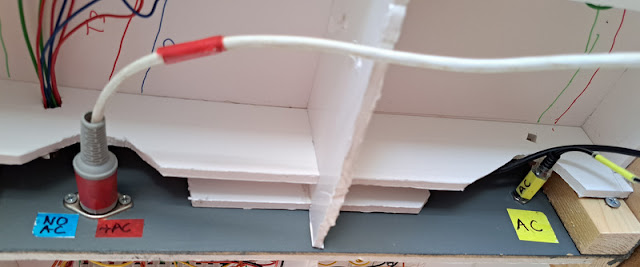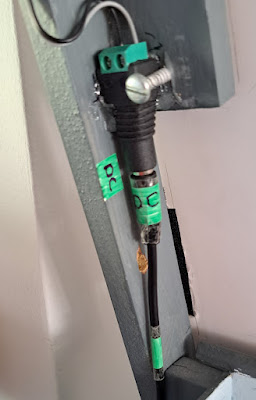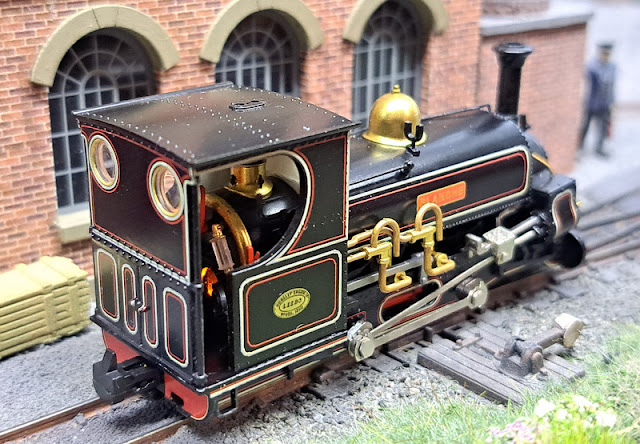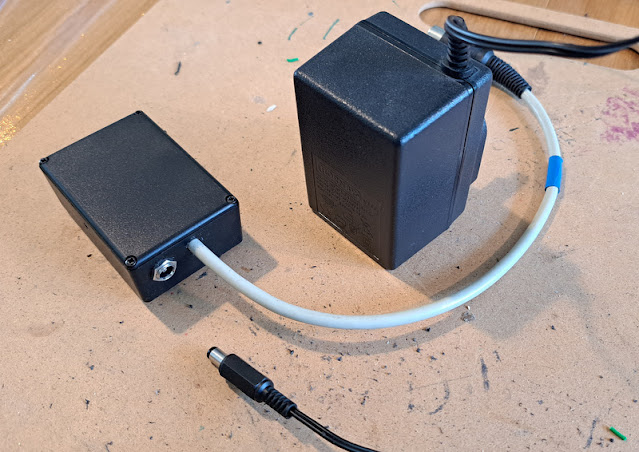Despite the back-to-front build I managed to get the fiddle yard constructed to fit to the Hexworthy baseboard, with a deck that slides to align tracks then slides right out to allow the deck to rotate. The rotating deck with end-gates that also lock the rotating deck to the sliding deck is pretty much unchanged, but most of the rest of what is seen here has been modified or reconstructed. Yes I do seem to over-complicate things! Next up will be the latching and electrical system.
Michael Campbell's blog about his model railways. Building model railway layouts in 009 (OO9) scale
Saturday, 30 September 2023
Rebuilding the "ultimate" fiddle yard
Despite the back-to-front build I managed to get the fiddle yard constructed to fit to the Hexworthy baseboard, with a deck that slides to align tracks then slides right out to allow the deck to rotate. The rotating deck with end-gates that also lock the rotating deck to the sliding deck is pretty much unchanged, but most of the rest of what is seen here has been modified or reconstructed. Yes I do seem to over-complicate things! Next up will be the latching and electrical system.
Wednesday, 20 September 2023
009 Society 50th Anniversary Exhibition - Statfold Barn
Last weekend the 009 Society celebrated its 50th anniversary with an exhibition held at the Statfold Barn Railway. Actually, "exhibition" feels a rather inadequate description. It was my first visit to Statfold, which is a privately owned narrow gauge railway and collection.
The Society had comissioned a special anniversay limited edition van from Peco. Of course I had to get one, and by the time the show opened on the Saturday morning it was out of the box and running on Slugworth, where it looked at home. In fact it ran around Slugworth pretty much all day so I estimate it must have covered around 2 real miles or so already.
The 50th celebrations were great fun, well organised, and memorable. Roll on 60 years...?
Monday, 11 September 2023
No crossed wires
As noted, the wall-wart 16V AC transformers have a very similar plug to the 12V DC power supplies used for the LED lighting. Clearly plugging in the wrong power supply could be bad (for the lights), so clear labelling is needed.
Friday, 8 September 2023
Blanche
For my birthday recently my wife got me a very nice present...
The cab interior is detailed too, and if you look closely you can see a glow in the firebox, this provides a flickering light in the cab as the loco moves. There are also etched plates in the box to be be fitted. As with recent Bachmann models the running is every bit as good as the looks too, smooth and controllable down to a crawl, and being a little heavier than recent Bachmann offerings it should be quite capable.
While I have pictured the loco on Loctern Quay, it's a little large (long overhangs) for Loctern and of course has the wrong couplings, I've found it difficult to fit Microtrains couplings to Bachmann locos. It will earn it's keep on Hexworthy in due course where it's fine lining will suit preservation era passenger trains. No doubt it will get some subtle weathering nonetheless, along with a crew of course.
Tuesday, 5 September 2023
Rethinking power supplies - Slugworth simplification
A while back I discovered that a simple Hornby "wall-wart" transformer could be used to power my layouts, a much neater and more compact solution than an open-frame transformer mounted in a home-made power box (see below). So I thought it worth getting another. This one is a Hornby C912 rather than the C990, it's rated 16V AC at 14VA which I make to be 875mA, so pretty much the same as the C990 which is rated 800 mA at 16V AC. Either type can be bought on ebay for less than £10.
When I made the "micro" power pack I'd just hard-wired the power lead in, but it seemed neater to fit a plug and socket, and allow the transformer to be interchangable - not least as I like to have a spare at exhibitions. The transformer comes with a 2.5mm (inner) x 5.5mm (outer diameter) power connector, so I used a matching socket from Squires, and refitted a matching plug to the existing transformer.
Now the folllowing gets a bit involved! There is a risk with these connectors in that the LED layout lighting uses the same/similar type for 12V DC. In fact, the 12V transformers seem to use 2.1x5.5 plugs which strangely fit 2.5x5.5 sockets, very confusing. I think if I adopt 2.1x5.5 sockets for the lighting they will still work with the 12V DC lighting supplies, but while the AC supply 2.5x5.5 plug will fit the socket the inner contact will not be made. This all seems a bit odd! In any case, some clear labelling may be needed.
The convenience of the wall-wart transfromers has made me rethink my power box strategy. The original design provided not just 16V AC to both controller and layout, and so 12V DC from the controller, but also a high-frequency track cleaner, and a capacitor discharge unit (CDU) for points, all fed to the layout via a 6-pin DIN plug. The idea was that it kept all the complex and relatively expensive components together in a box that can power any of my layouts, rather than having to add them to each layout.
Now, I no longer use a high-frequency track cleaner, modern motors don't like them and anyway the use of graphite on the rails has made them redundant. I've also found that the points on a small layout can be driven via a simple CDU made of 3 components in a choc-block connector, as provided in the mini power box seen above. However, some layouts - such as Slugworth - use manual points control and don't even need the CDU, so the mini power box is now simply a junction box. Clearly, it can be eliminated altogether...
So Slugworth has been modified by the addition of a 16V AC input socket for the transformer. This is wired into the 6-pin DIN socket. Now a 5-pin DIN controller plug will fit a 6-pin DIN socket, and fortuitously when I first wired my power box leads I matched the controller 12V DC and 16V AC pins between the 5 and 6 pin connectors (although for the controller the 16V flows in, from the power box it flows out). So here the controller can plug into the 6-pin socket and both it and the auxilliary 16V AC supply (e.g. for lighting) are powered from the plug-in wall-wart transformer, with no external junction or power pack needed.
Of course, as the existing wiring is unchanged the power box can still be used with the controller plugged into that, and no separate transformer is plugged into the layout. This seems a bit complex but hopefully the diagram makes sense.
I did add a thermal trip to the 16V AC supply, I expect these sealed transformers have one built in but better safe than sorry. This trips at 1.6A which may be a bit high, but if there is a short it should trip.
This view underside of Slugworth shows the existing socket (left) with the controller plugged in, and on the right the new power socket for the 16V AC transformer wired to both the controller socket and to the lighting power circuitry. Of course this is how many people already wire up their layouts, but the approach I've used maintains "backward compatibility" for the existing power box to be used instead, or as a back-up.
This simple modification could be made to any of my smaller layouts to eliminate the need for a separate power box (and another lead), and just use a cheap wall-wart transformer. Layouts that need a CDU for point control could have the simple circuit added on-board too, although for now the micro power box used on Loctern Quay does that job.
Sunday, 3 September 2023
Bagnall and Kerr Stuart completed
Both the Narrow Planet little Bagnall kit and the Paul Windle Kerr Stuart refurbishment are now finished. I decided to break out the airbrush using Vallejo mid green, of course I had to clean the airbrush before use as my previous clean clearly wasn't good enough. I struggled to get a good finish to start with so the first coat was perhaps a little orange-peely, but in the end got a reasonable finish.






























